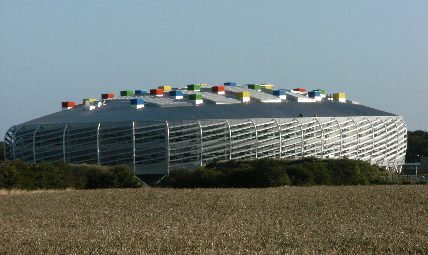A Cambridge spin-out has developed a completely new way of ventilating buildings that has the potential to reduce heating bills by as much as 50 percent while drastically reducing energy consumption. The natural ventilation technology concept exploits the heat produced by people, lights, IT and even sunlight, avoiding the wasteful use of radiators.
Breathing Buildings, which spun out of the University of Cambridge in 2006, is based on research originally conducted at the University’s BP Institute exploring new ways of constructing energy-efficient buildings. While at Cambridge, the researchers devised a way to harvest the existing heat in a building and mix it with fresh air. This led to the development of the technology that Breathing Buildings now incorporates into the design of new buildings.
Engineer Dr Shaun Fitzgerald, who led the industrial interface for the research programme at the University and is now Breathing Buildings’ CEO, says that the company’s solution is “wonderfully simple.” It captures the heat generated by people and equipment and adds cooler outside air to maintain air quality and comfortable temperatures, using a minimum of energy. Instead of the classic British open-windows-plus-radiators approach, Breathing Buildings’ technology consists of an exterior opening, a mixing chamber and two low-energy fans. One fan pulls warm interior air into the chamber, and the other mixes it with fresh air, regulating the temperature and eliminating draughts. Ventilation in winter is determined by CO2 levels indoors, while the temperature is maintained by sensors in the unit. A control algorithm regulates the damper, fan speeds and fan directions.
Nearly every building in the UK can be naturally ventilated year-round, without the need for any mechanical systems.
Dr Shaun Fitzgerald
Breathing Buildings’ technology works best in temperate climates like the UK, where the external temperature during daylight hours is between five and 16 degrees for the majority of the year. “Nearly every building in the UK can be naturally ventilated year-round, without the need for any mechanical systems,” says Dr Fitzgerald. The exceptions are buildings which are both extremely tall and extremely deep, such as a London skyscraper.
The company also piggybacks its technology with conventional mechanical ventilation systems for abnormally hot or cold days, or for climates which are more variable. The award-winning Costa eco-pod in Telford is the most recent hybrid scheme developed by Breathing Buildings. It combines air-conditioning for the very hottest days with natural ventilation at other times. Most of Breathing Buildings’ sales are to the construction industry, where intelligent ventilation systems are an important consideration in new building design.
The company was one of ten named as New Energy Pioneers by Bloomberg New Energy Finance in April 2014. Providing energy to buildings accounts for around 40 percent of consumption in the developed world. Tackling inefficient ventilation systems is one of the primary ways to reduce this. Compared with mechanical systems, which use several hundred watts of energy to ventilate a typical classroom, Breathing Buildings’ natural ventilation technology uses zero energy in warmer weather and only 60 watts in winter.
The technology has been implemented in more than 300 buildings in the UK, including schools, offices and supermarkets, and installations are now underway in the United States. Most recently it’s been incorporated in the University of Cambridge’s James Dyson building, which opened in May 2016. The building, which houses part of the Engineering Department, is completely ventilated with Breathing Buildings equipment.
Image: Monkseaton High School in Whitley Bay, courtesy of Breathing Buildings




